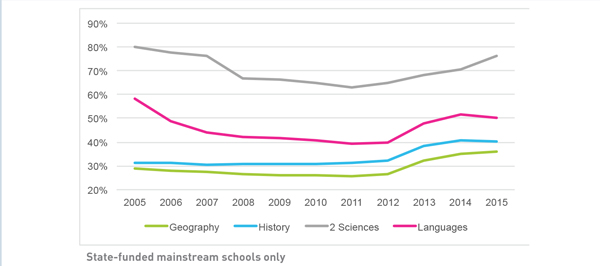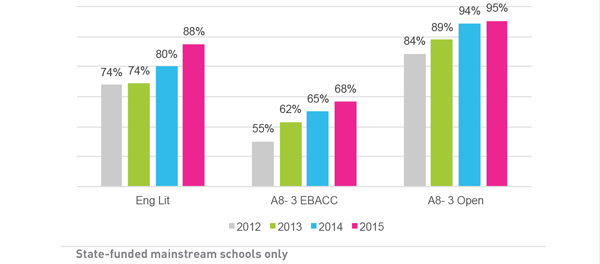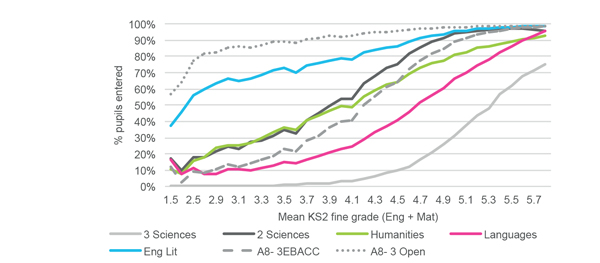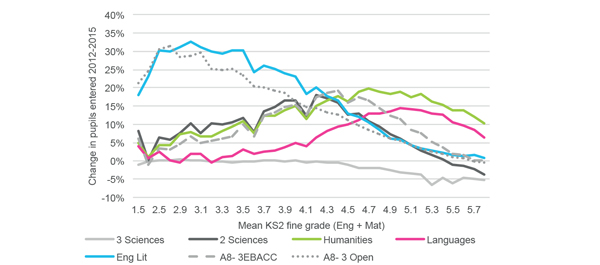In 2010 the government added a measure to school league tables. It signalled how many children studied a set of subjects called the ‘EBacc’. How did schools respond, and who did it actually help? Sophie Scott investigates
Schools are changing access to English Baccalaureate (EBacc) subjects, but not all pupils are equally affected, new figures by Education Datalab reveal.
Analysis by the research group shows that since 2012 schools have amended their curriculum offer so more pupils study a “core” of English, maths, science, a modern foreign language (MFL), or history and geography through to GCSE.
Last week education secretary Nicky Morgan said 90 per cent of pupils starting secondary school this year are expected to achieve GCSEs in the EBacc subjects.
But one of the main findings from Education Datalab is that schools are entering pupils into EBacc subjects at different rates, according to their ability.
English literature is now taken by almost 90 per cent of pupils – mainly because, says Education Datalab, more pupils with lower ability are taking the subject compared with three years ago.
The proportion of higher ability pupils taking the subject has, however, remained constant in the past three years.
In foreign languages, by contrast, lower ability pupils are only marginally more likely to study it to GCSE compared with three years ago; whereas high ability pupils have increased their language take-up by about 15 per cent.
Education Datalab director Becky Allen said the upcoming changes in accountability measure mean results in either English language or literature count towards the school’s overall performance.
She suggested it was now more “desirable” to have pupils studying both English subjects as the best result was doubled when both had been entered, boosting the school’s overall performance figures.
With languages, Dr Allen suggested a lack of teachers could be limiting numbers. Schools Week previously reported that more than 2,000 extra language teachers are needed if all pupils study languages to GCSE.
“Non-specialists can’t teach languages, like someone could geography or history,” Dr Allen said. “If you can’t speak French, you can’t teach it. So it is here that schools are likely to feel the crunch.”
Science also looks to have seen a positive increase since the EBacc’s introduction with 80 per cent of pupils now taking double science compared with just 60 per cent in 2011.
But this is at a detriment to triple science. Education Datalab’s analysis shows a 5 per cent drop among higher ability pupils taking the subject.
The aim of the report is to provide school leaders with intelligence on what other schools with similar ability intakes are teaching.
Dr Allen said that at schools with higher ability more challenging intakes, there is massive diversity in how schools have chosen for the EBacc.
The shift towards mandatory EBacc for nearly all pupils could, however, lead to schools becoming much more similar in their GCSE curriculum offers.
“But do we want schools to compete with diverse subject offerings? Or, do we actually want children to have a relatively standard curriculum up to age 16?”
1 – Entry rates for EBacc subjects, 2005-2015

Education Datalab’s analysis shows how the subjects pupils are studying in years 10 and 11 has changed since 2012.
The percentage of pupils taking double science this year almost hit the same level as in 2005 (80 per cent).
As shown in graph 4, this could be because 5 per cent fewer pupils of high ability are now taking triple science.
Languages is still not up to 2005 levels (pink). A decade ago, 60 per cent of pupils studied another language. Currently it sits at about 50 per cent.
2 – Entry Rates 2012-2015

The number of pupils studying English literature has increased over the past three years.
Now, almost 90 per cent of pupils are entered for the subject, compared with just 74 per cent in 2012 and 2013.
Education Datalab notes the impact of the Wolf review Ð on the back of which the coalition government announced vocational subjects would no longer count towards school league tables.
Datalab says the three ‘open’ slots for Progress 8 are already being filled (with 95 per cent of pupils going down this route), signalling a move away from vocational qualifications.
3 – 2015 subject entry rates by pupil prior attainment

Datalab analysed pupil entries into GCSE subjects based on their point score upon starting secondary school.
An average pupil started school with 3.9 Ð the middle of the horizontal scale.
Any pupil to the left of 3.9 is ‘below average’ in ability, and those to the right are ‘above average’.
The graph shows that at least 50 per cent of the lowest ability pupils studied English literature (the blue line). Whereas, fewer than 20 per cent take a language (pink).
No pupils with below average ability currently take triple science.
At the other end of the ability range, almost 100 per cent of the most academically able took English literature, humanities and a language.
4 – Change in subject entry rates between 2012 and 2015

Keeping 3.9 as the ‘average ability’ of pupils (as in graph 3), the above graph shows the change in subject entry rates over the past three years.
Up to 32.5 per cent more pupils with lower ability (to the left) have been entered for English literature compared with 2012. However, there has only been a 5 per cent increase in lower ability pupils being given the option to take languages.
Up to 15 per cent more of the higher ability pupils take languages, with the main push coming from those pupils just under the highest ability.
Triple science take up has declined for all pupils Ð with 5 per cent fewer pupils taking it at the top end of ability.






Your thoughts